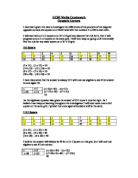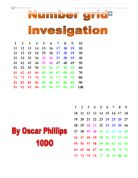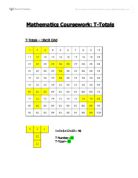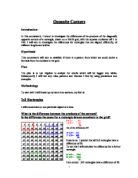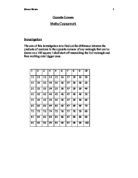About Triangular Square Numbers
About Triangular Square Numbers By August Pieres January 18th, 2003 I believe I have discovered an algorithm which generates an infinity of triangular squares. "Triangular squares" are triangular numbers which are also perfect squares. These are triangular numbers: 1,3,6,10,15,21,28,36,45,55,66,78,91,105,120,136,153,171,190,210,... Notice that 120=5! (and 6=3!) and that 1,3,21, and 55 are also Fibonacci numbers; one might call them "Fibonacci triangles." Are there any more Fibonacci triangles? These are the perfect squares: 1,4,9,16,25,36,49,64,81,100,121,144,169,196,225,256,289,324,361,400,... The only triangular squares listed so far are 1 and 36. Earlier today I thought that these were the only existing triangular squares, but I found out that there are more and quite possibly an infinity of them. I made a program on my programmable Texas Instruments TI-86 calculator. Here it is: PROGRAM:TRISQUAR -->N Lbl A N*(N+1)/2-->M If ?M==iPart?M Then Disp M End +N-->N Goto A I ran the simple program above and it found the following additional triangular squares: 1225, 41616, 1413721. Then I "played" with these new numbers -- with the help of the calculator -- trying to find patterns. To each triangular square corresponds a pair of parameters: s and t, such that a triangular square N is the sth perfect square and the tth triangular number, i.e. N=s2=Tt. So
China in the 20th Century Sources Questions
Affia Mustafa 11D Modern World Study China in the 20th Century Coursework Assignment 4 . The article, 'Dissidents stalked by Chinese police', describes how, after the Tiananmen Square incident, citizens were literally stalked by the police for 're-education'. Wang Hui, a Chinese citizen, was believed to be taken in by the police because she objected to the unjust arrest of her husband. Her friends have reason to believe that after failure to contact Wang Hui, they could only conclude one thing; the police, following her husband's arrest, had taken her. "...Police began continuous surveillance of Wang Hui, the wife of jailed activist Zhou Guioqiang. Concern for her safety intensified yesterday after she failed to make contact with friends for two days. They fear she could be held by the police." Before the article was written, the citizens had a special 'code' to make sure that the networks of houses located to them were always safe. The method was by telephoning each other at set times during the day. This would make sure that the little 'circle' of friends is still safe from the police. This method was also efficient in a way that if anyone did get taken away then they would be alerted very quickly. This new method of taking the spouse away was relatively new. Before this law was enforced, "Such tactics mark a change in how authorities deal with spouses seeking
T-Shape investigation.
T-Shape Firstly, I am going to look at the relationship between the t-number and the t-total. I am going to refer to these terms using the letters N and Z: n = t-number z = -total I will take the first t-shape at the top left of a 9 x 9 size grid. 2 3 4 0 1 2 3 9 20 21 22 28 29 30 31 37 38 39 40 I predict that if I move the t-shape to a different location the t-total will be the t-number + 17 (n+17) 2 3 4 5 6 7 0 1 2 3 4 5 6 9 20 21 22 23 24 25 28 29 30 31 32 33 34 37 38 39 40 41 42 43 If my prediction is correct, t-total should equal 40 (23 + 17 = 40) Z = 4+5+6+14+23=52 My prediction is not correct. I will move the t-shape to the right and tabulate my results to see if there is a pattern. n 20 23 26 z 37 52 67 The t-total is in creasing by 15. Using first differences I will try to find a formula. n 20 23 26 5n 300 345 390 -263 -293 -323 z 37 52 67 I cannot find a formula for this. However, I have noticed that my n value is increasing by 3 every time. I will re-tabulate my results so it increases by 1 each time. This will make the numbers smaller and closer together and easier to spot a pattern. n 20 21 22 23 24 25 z 37 42 47 52 57 62 There is a definite pattern. The z value is increasing by 5 each time. I will try and find a formula. n 20 21 22 23 24 25 5n 00
Explaining the Principle of mathematical induction
Explaining the Principle of mathematical induction: Formally the principle of a proof by induction can be stated as follows: A proposition P (n) involving a positive integer n, is true for all positive integral values of n if, P (1), and P (k) ? P (k +1) is true. This can be explained using a staircase as a simple analogy. Image the proposition that a man can climb a given uniform staircase, to prove this statement we need to show two things. These are that the man can get onto the first step and that he is able to climb from one step to an other. Now relating this to the formal principle of induction, the staircase can be considered the general proposition P (n). The first step of the staircase is P (1), the second P (2), the third P (3), and so on. If we can show that the man can get onto the first step P (1) then we have ironically finished the first step of proving the proposition. The second step would be to prove that he can get from one step to an other formally put P (k) ? P (k +1). If we can show this than it follows that man can get from the first to the second step, second to the third,... n steps. Thus it can be said that P (n) is true for all positive integral values of n. 2 Definition of the derivative function f (x) The derivative function is a general expression for the gradient of a curve at any given point. It is based on the principle of limiting
Investigate how to calculate the total number of Winning Line
GCSE Mathematics Coursework: Connect 4: Investigate how to calculate the total number of Winning Lines Task In my investigation I am going to look at change in grid size and winning line length. From this I am aiming to be able to predict the number of winning lines in any size square grid with any winning line length I am planning to do this through modelling situations and finding links in my results when in a results table so I can calculate working algebraic formulae. I will achieve this by first devising a rule to calculate the total number of horizontal winning lines, vertical winning lines and diagonal winning lines in a square grid. In my investigation I am making the following assumptions; * The grid is a square * Winning line length is known * Grid size is known * The Winning line length is equal or less than the Grid side length, because if not the total number of winning lines is zero. * 1 is not a valid line length because it is only one point of the grid. * The grid below is a 4x4 grid. . . . . . . . . . . . . . . . . I will investigate the following: * Number of horizontal winning lines in any size square grid with any winning line length. * Number of vertical winning lines in any size square grid with any winning line length. * Number of diagonal winning lines in any size square grid with any winning line
I will try to find a formula linking P (perimeter), D (dots enclosed) and T (number of triangles used to make a shape). Later on in this investigation T will be substituted for Q
GCSE Maths Coursework - Shapes Investigation Summary I am doing an investigation to look at shapes made up of other shapes (starting with triangles, then going on squares and hexagons. I will try to find the relationship between the perimeter (in cm), dots enclosed and the amount of shapes (i.e. triangles etc.) used to make a shape. From this, I will try to find a formula linking P (perimeter), D (dots enclosed) and T (number of triangles used to make a shape). Later on in this investigation T will be substituted for Q (squares) and H (hexagons) used to make a shape. Other letters used in my formulas and equations are X (T, Q or H), and Y (the number of sides a shape has). I have decided not to use S for squares, as it is possible it could be mistaken for 5, when put into a formula. After this, I will try to find a formula that links the number of shapes, P and D that will work with any tessellating shape - my 'universal' formula. I anticipate that for this to work I will have to include that number of sides of the shapes I use in my formula. Method I will first draw out all possible shapes using, for example, 16 triangles, avoiding drawing those shapes with the same properties of T, P and D, as this is pointless (i.e. those arranged in the same way but say, on their side. I will attach these drawings to the front of each section. From this, I will make a list of all
Investigate the number of winning lines in the game Connect 4.
Year 11 mathematics coursework - Connect 4 Investigation. This is a winning line in the game Connect 4 on a 4x5 board. Winning lines can be horizontal, vertical or diagonal. Investigate the number of winning lines in the game Connect 4. The task asks for an investigation of the number of Connect 4 solutions in different sized grids. In Connect 4 the rules are that a winning line is a straight line of four connected counters in either a vertical, horizontal or diagonal line. To investigate this I must count the total number of possible winning solutions in a grid. The grid does not have too be any particular size however I will begin my investigation by using small grids, therefore the number of solutions will be smaller and easier to count. My results will be recorded in tables to make it easier to spot any patterns or trends. My aim is to establish formulae's that will enable me too calculate the total number of winning lines for any given grid size. These are the steps I will take to complete the set task: . I will draw a range of differently sized grids and count the total amount of possible winning solutions each has on it, this will aid me in creating a formula. 2. After I have gathered all my results I will record them in tables. 3. Using the table I will look for patterns and possible links. 4. Using the data I have collected I will attempt to calculate a
Investigate the differences between products in a controlled sized grid.
Aim I am going to investigate the differences between products in a controlled sized grid. Method I am going to keep the grid size the same. Keeping the number of rows and columns the same. I am going to change the position of the box and the size of the size of the box altering the number of rows and columns. Investigation on 2by 2 boxes in a 10 by 10 grid. 2 3 4 5 6 7 8 9 0 1 2 3 4 5 6 7 8 9 20 21 22 23 24 25 26 27 28 29 30 31 32 33 34 35 36 37 38 39 40 41 42 43 44 45 46 47 48 49 50 51 52 53 54 55 56 57 58 59 60 61 62 63 64 65 66 67 68 69 70 71 72 73 74 75 76 77 78 79 80 81 82 83 84 85 86 87 88 89 90 91 92 93 94 95 96 97 98 99 00 I am now going to multiply opposite numbers together in the box. This is to show the differences. 2 1 2 *12=12 1*2=22 DIFFERENCE=10 9 0 9 20 9*20=180 9*100=190 DIFFERENCE=10 36 37 46 47 36*47=1692 37*46=1702 DIFFERENCE=10 Table of results 2 1 2 9 0 9 20 A B A B C D C D 36 37 46 47 A B C D I have called these numbers A, B, C, D so that it will be easier to see the results in the table. It will also be easier to see which numbers I am going to multiply together. Number A Number B Number C Number D Product of A*D Product of B*C Product of A*D- product of B*C 2 1 2 2 22 0 9 0 9 20 80 90 0 36
Number Grids Investigation
Sophie Johnson 10A6 Maths Coursework Number Grids The diagram shows a 10*10 grid, a rectangle has been shaded on the 10*10 grid. I will find the diagonal difference between the products of the numbers in the opposite corners of the rectangle. 2 3 4 5 6 7 8 9 0 1 2 3 4 5 6 7 8 9 20 21 22 23 24 25 26 27 28 29 30 31 32 33 34 35 36 37 38 39 40 41 42 43 44 45 46 47 48 49 50 51 52 53 54 55 56 57 58 59 60 61 62 63 64 65 66 67 68 69 70 71 72 73 74 75 76 77 78 79 80 81 82 83 84 85 86 87 88 89 90 91 92 93 94 95 96 97 98 99 00 Opposite numbers in the rectangle are:- 54 and 66 56 and 64 56*64=3584 54*66=3564 .·. The Diagonal Difference = 3584 - 3564 = 20 Study I have studied some more 3*2 rectangles and I have found this:- 2 3 4 22 23 24 74 75 76 84 85 86 27 28 29 37 38 39 So from this I conclude that all 3*2 rectangles have a diagonal difference of 20. After doing this I wondered if this theory would work if I used a 2*3 rectangle. 27 28 37 38 47 48 34 35 44 45 54 55 So I then from this I wondered if larger rectangles had the same diagonal difference from this I found: - Rectangle Rows * columns Diagonal difference 2*3 20 3*4 60 4*5 20
Maths Investigation- Grids
Karen Ng 10H Maths Investigation- Grids The first part of my task was to investigate the number of squares, which can be drawn on grids made from 11 lines. I used 11 lines to make different grids on paper, alternating the use of lines. Starting with 1 horizontal and 10 vertical lines I work up (or down) so my grid then is 2 horizontal and 9 vertical. I counted the number of squares by outlining the shape of the square; this is shown in diagram 3. Here is my table of results using 11 lines only. Lines Down Lines Across x1 square 2x2 Square 3x3 square 4x4 square Total Squares 0 0 0 0 0 0 0 0 0 0 0 0 0 9 2 8 0 0 0 8 8 3 4 6 0 0 20 7 4 8 0 4 3 35 6 5 20 2 6 2 40 5 6 20 2 6 2 40 4 7 8 0 4 3 35 3 8 4 6 0 0 20 2 9 8 0 0 0 8 0 0 0 0 0 0 0 0 0 0 0 0 0 As you can see, after the 6x5 result comes up, the rest of the results are exactly the same as the ones at the top, because 6x5 is the same as 5x6 and etc. After a while of studying the table, I found out the rule was, say if you were trying to find out how many 1x1 squares were in a 6x5 grid, you would do 6-1=5 and 5-1=4, then, you times the answer ( 5 and 4 ) together, and that number will be the amount of 1x1 squares you will get in the grid. To find out how many 2x2 squares are in a grid, you do exactly the same thing, except you














